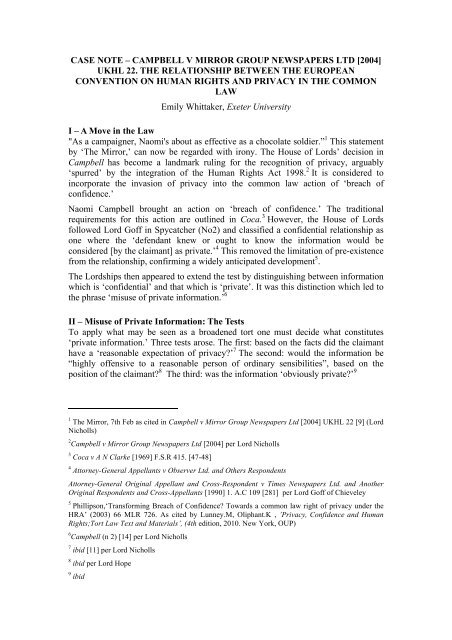Open UKLSR Volume 1(2) - Uklsa
Open UKLSR Volume 1(2) - Uklsa
Open UKLSR Volume 1(2) - Uklsa
Create successful ePaper yourself
Turn your PDF publications into a flip-book with our unique Google optimized e-Paper software.
CASE NOTE – CAMPBELL V MIRROR GROUP NEWSPAPERS LTD [2004]<br />
UKHL 22. THE RELATIONSHIP BETWEEN THE EUROPEAN<br />
CONVENTION ON HUMAN RIGHTS AND PRIVACY IN THE COMMON<br />
LAW<br />
Emily Whittaker, Exeter University<br />
I – A Move in the Law<br />
"As a campaigner, Naomi's about as effective as a chocolate soldier.” 1 This statement<br />
by ‘The Mirror,’ can now be regarded with irony. The House of Lords’ decision in<br />
Campbell has become a landmark ruling for the recognition of privacy, arguably<br />
‘spurred’ by the integration of the Human Rights Act 1998. 2 It is considered to<br />
incorporate the invasion of privacy into the common law action of ‘breach of<br />
confidence.’<br />
Naomi Campbell brought an action on ‘breach of confidence.’ The traditional<br />
requirements for this action are outlined in Coca. 3 However, the House of Lords<br />
followed Lord Goff in Spycatcher (No2) and classified a confidential relationship as<br />
one where the ‘defendant knew or ought to know the information would be<br />
considered [by the claimant] as private.’ 4 This removed the limitation of pre-existence<br />
from the relationship, confirming a widely anticipated development 5 .<br />
The Lordships then appeared to extend the test by distinguishing between information<br />
which is ‘confidential’ and that which is ‘private’. It was this distinction which led to<br />
the phrase ‘misuse of private information.’ 6<br />
II – Misuse of Private Information: The Tests<br />
To apply what may be seen as a broadened tort one must decide what constitutes<br />
‘private information.’ Three tests arose. The first: based on the facts did the claimant<br />
have a ‘reasonable expectation of privacy?’ 7 The second: would the information be<br />
“highly offensive to a reasonable person of ordinary sensibilities”, based on the<br />
position of the claimant? 8 The third: was the information ‘obviously private?’ 9<br />
1 The Mirror, 7th Feb as cited in Campbell v Mirror Group Newspapers Ltd [2004] UKHL 22 [9] (Lord<br />
Nicholls)<br />
2 Campbell v Mirror Group Newspapers Ltd [2004] per Lord Nicholls<br />
3 Coca v A N Clarke [1969] F.S.R 415. [47-48]<br />
4 Attorney-General Appellants v Observer Ltd. and Others Respondents<br />
Attorney-General Original Appellant and Cross-Respondent v Times Newspapers Ltd. and Another<br />
Original Respondents and Cross-Appellants [1990] 1. A.C 109 [281] per Lord Goff of Chieveley<br />
5 Phillipson,‘Transforming Breach of Confidence? Towards a common law right of privacy under the<br />
HRA’ (2003) 66 MLR 726. As cited by Lunney.M, Oliphant.K , ’Privacy, Confidence and Human<br />
Rights;Tort Law Text and Materials’, (4th edition, 2010. New York, OUP)<br />
6 Campbell (n 2) [14] per Lord Nicholls<br />
7 ibid [11] per Lord Nicholls<br />
8 ibid per Lord Hope<br />
9 ibid


